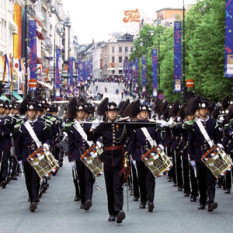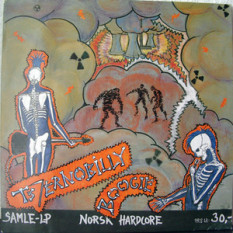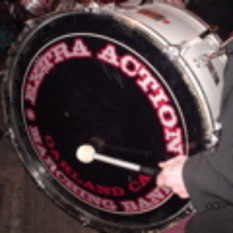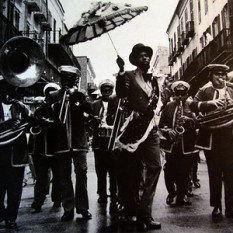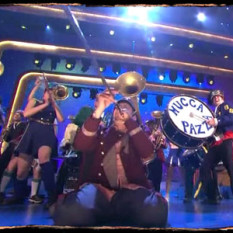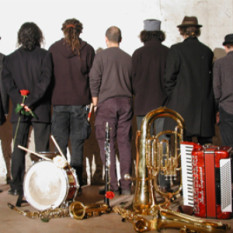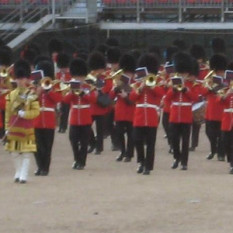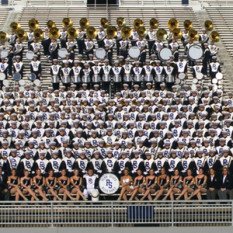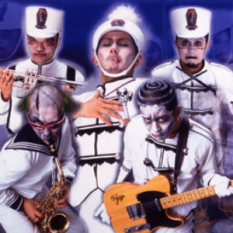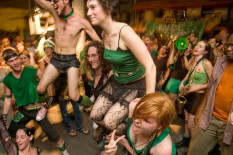A marching band is a group of instrumental musicians, often accompanied by dance teams and/or a color guard (known as auxiliaries), who generally perform outdoors and incorporate some type of marching (and possibly other movements) with their musical performance. Instrumentation typically includes brass, woodwinds, and percussion instruments.
The marching band originated with traveling musicians who performed together at festivals and celebrations throughout the ancient world. It evolved and became more structured within the armies of the early city-states, becoming the basis for the military band, from which the modern marching band emerged. As musicians became less important in directing the movement of troops on the battlefield, the bands moved into increasingly ceremonial roles - an intermediate stage which provided some of the instrumentation and music for marching bands was the modern brass band, which also evolved out of the military tradition. Outside of police and military organizations, modern marching bands are often associated with American football, specifically the halftime show.
Marching bands are generally categorized by function, size and the style of show they perform. Military bands and Corps of Drums were historically the first marching bands. Instrumentation varies, but generally contains brass and percussion. Music is performed at a constant tempo to facilitate the steady marching of the entire military group with which the band is playing. This style can include classic drum and bugle corps, pipe bands and fife and drum corps.
Drum and bugle corps is a genre of marching ensemble descended from military signaling units. It is distinctly divided into classic and modern corps. As the name implies, bugles and drums form the musical background of the corps, but modern competitive drum corps incorporate other brass instruments and orchestral percussion.
Show bands primarily perform on fields (for example, a football field) and serve the purpose of providing entertainment during sporting events, going to competitions (especially at the high school level), and occasionally performing at parades and other events. Depending on the type of show band, the instrumentation can contain entirely brass instruments and percussion instruments, and may or may not use woodwinds or a percussion pit.
Carnival bands are a UK variant of show bands. They contain brass and percussion, but may or may not use woodwinds.
The size and composition of a marching band can vary greatly. Some bands have fewer than twenty members, and some have over 500. American marching bands vary considerably in their instrumentation. Some bands omit some or all woodwinds, but it is not uncommon to see piccolos, flutes, clarinets, alto saxophones, and tenor saxophones. E♭ clarinets, alto clarinets, bass clarinets, and baritone saxophones are less common, but can be found in some bands. Bassoons and oboes are very seldom found on a field due to the risk of incidental damage, the impracticality of marching with an exposed double reed, and high sensitivity to weather.
The brass section usually includes trumpets or cornets, mellophones or alto horns (instead of horns), tenor trombones, baritone horns or euphoniums, and tubas or sousaphones. E♭ soprano cornets are sometimes used to supplement or replace the high woodwinds. Some especially large bands use flugelhorns and bass trombones.
Marching percussion (often referred to as the drumline, battery, or back battery) typically includes snare drums, tenor drums, bass drums, and cymbals and are responsible for keeping tempo for the band. All of these instruments have been adapted for mobile, outdoor use. Marching versions of the glockenspiel (bells), xylophone, and marimba are also rarely used by some ensembles. Historically, the percussion section also employed mounted timpani that featured manual controls.
For bands that include a front ensemble (also known as the pit or auxiliary percussion), stationary instrumentation may include orchestral percussion such as timpani, tambourines, maracas, cowbells, congas, wood blocks, marimbas, xylophones, bongos, vibraphones, timbales, claves, guiros, and chimes or tubular bells,concert bass drums, and gongs, as well as a multitude of auxiliary percussion equipment. Drum sets, purpose-built drum racks, and other mounted instruments are also placed here. Until the advent of the pit in the early 1980s, many of these instruments were actually carried on the field by marching percussionists by hand or on mounting brackets. Some bands also include electronic instruments such as synthesizers, electric guitars, and bass guitar, along with the requisite amplification. If double-reed or string instruments are used, they are usually placed here, but even this usage is very rare due to their relative fragility. Unusual percussive instruments are sometimes used, including brake drums, empty propane tanks, trashcans, railroad ties, stomping rigs, and other items to make interesting sounds. .

